Sustainable Operations and Supply Chain Management at Samsung
VerifiedAdded on 2023/06/10
|11
|2496
|294
Report
AI Summary
This report provides an analysis of Samsung's sustainable operations and supply chain management practices. It begins by outlining Samsung's products, services, delivery methods, quality standards, and associated supply chain processes, emphasizing the role of Information and Communication Technology (ICT). The report then delves into an organizational analysis, utilizing diagnostic tools like Performance Measures (QSDFC) to evaluate Samsung's sustainability efforts. Findings are explained in detail, highlighting both positive and negative aspects affecting the company's operations, performance, productivity, and profitability. The report concludes by summarizing the key aspects of sustainable operations and supply chain management within Samsung, emphasizing the importance of ICT and continuous improvement through performance measurement tools.
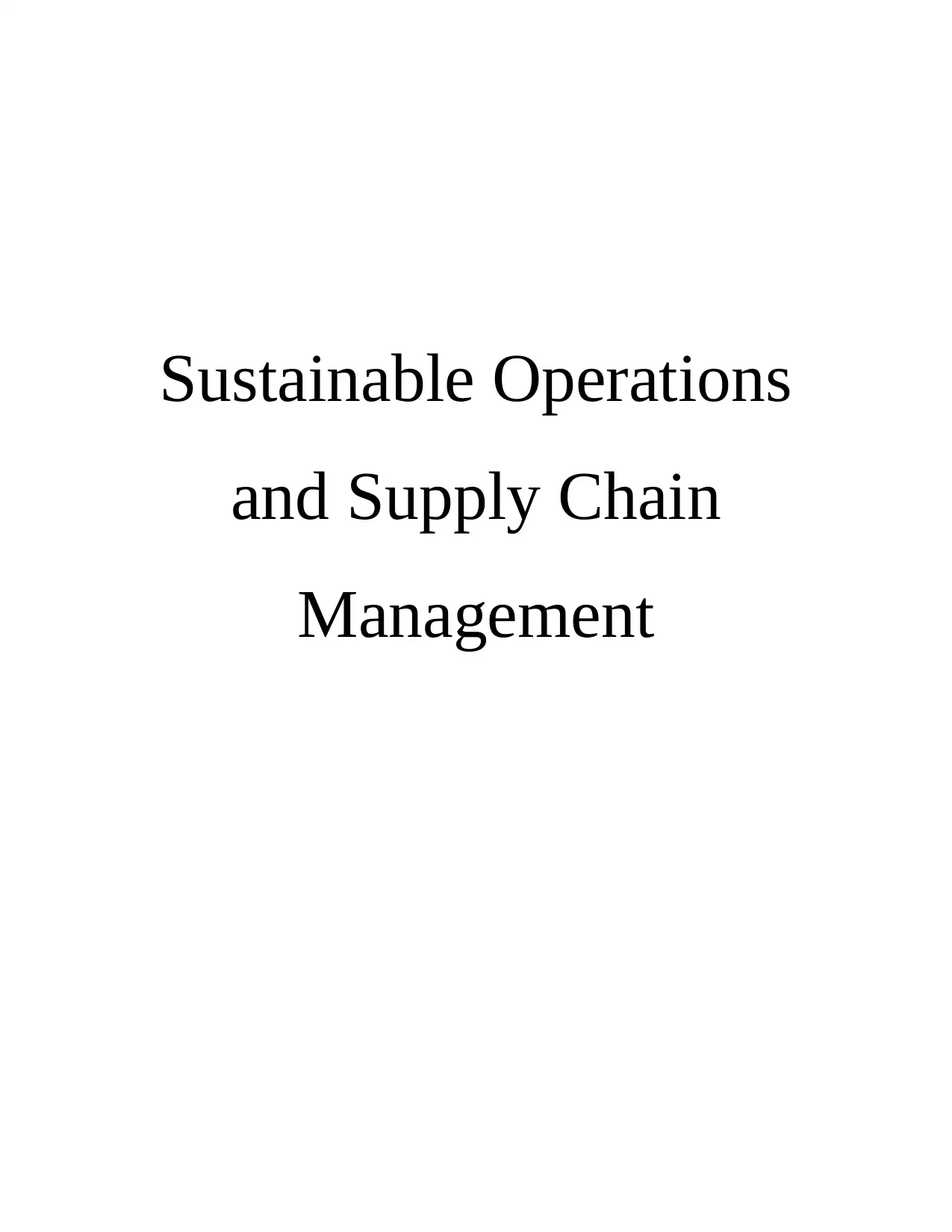
Sustainable Operations
and Supply Chain
Management
and Supply Chain
Management
Paraphrase This Document
Need a fresh take? Get an instant paraphrase of this document with our AI Paraphraser
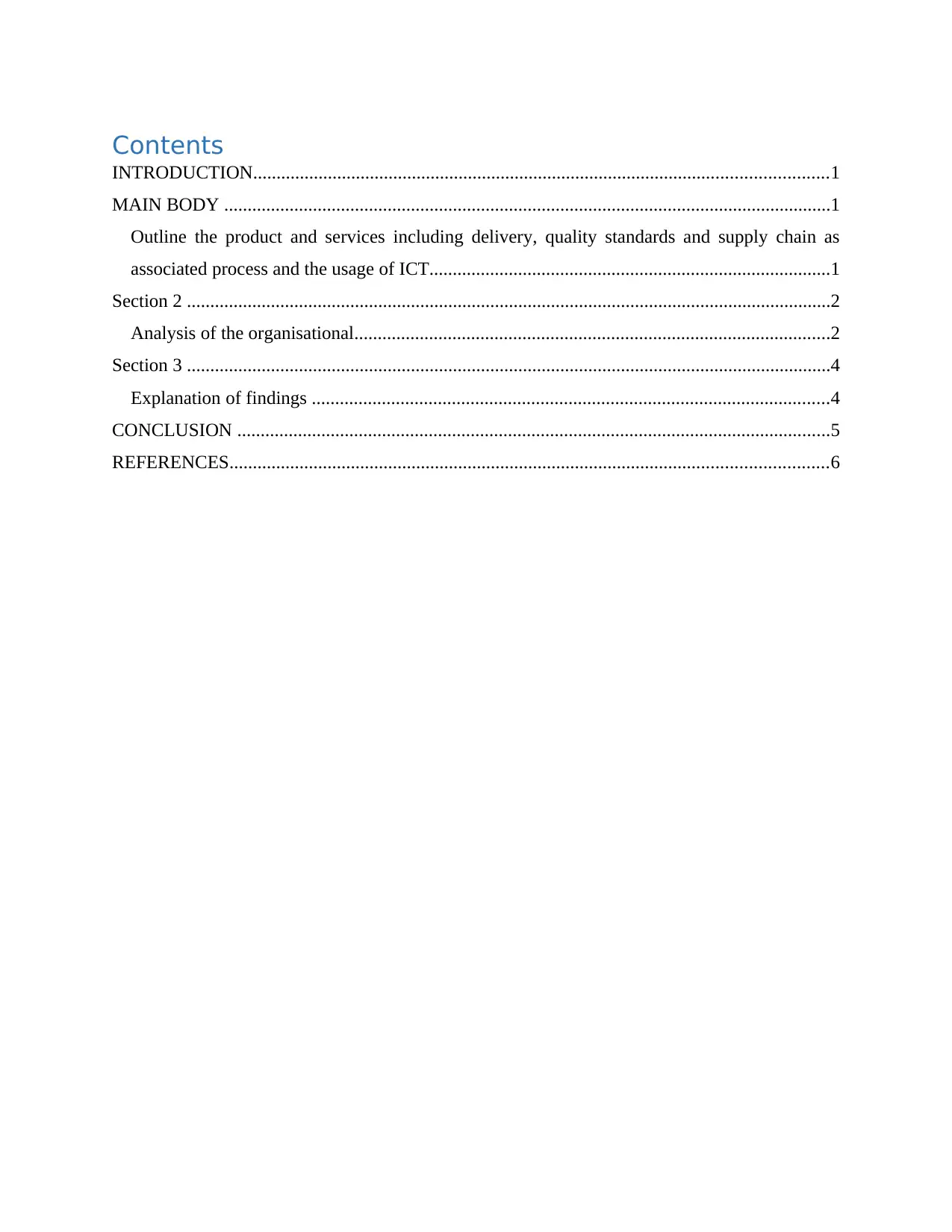
Contents
INTRODUCTION...........................................................................................................................1
MAIN BODY ..................................................................................................................................1
Outline the product and services including delivery, quality standards and supply chain as
associated process and the usage of ICT......................................................................................1
Section 2 ..........................................................................................................................................2
Analysis of the organisational......................................................................................................2
Section 3 ..........................................................................................................................................4
Explanation of findings ...............................................................................................................4
CONCLUSION ...............................................................................................................................5
REFERENCES................................................................................................................................6
INTRODUCTION...........................................................................................................................1
MAIN BODY ..................................................................................................................................1
Outline the product and services including delivery, quality standards and supply chain as
associated process and the usage of ICT......................................................................................1
Section 2 ..........................................................................................................................................2
Analysis of the organisational......................................................................................................2
Section 3 ..........................................................................................................................................4
Explanation of findings ...............................................................................................................4
CONCLUSION ...............................................................................................................................5
REFERENCES................................................................................................................................6

⊘ This is a preview!⊘
Do you want full access?
Subscribe today to unlock all pages.

Trusted by 1+ million students worldwide
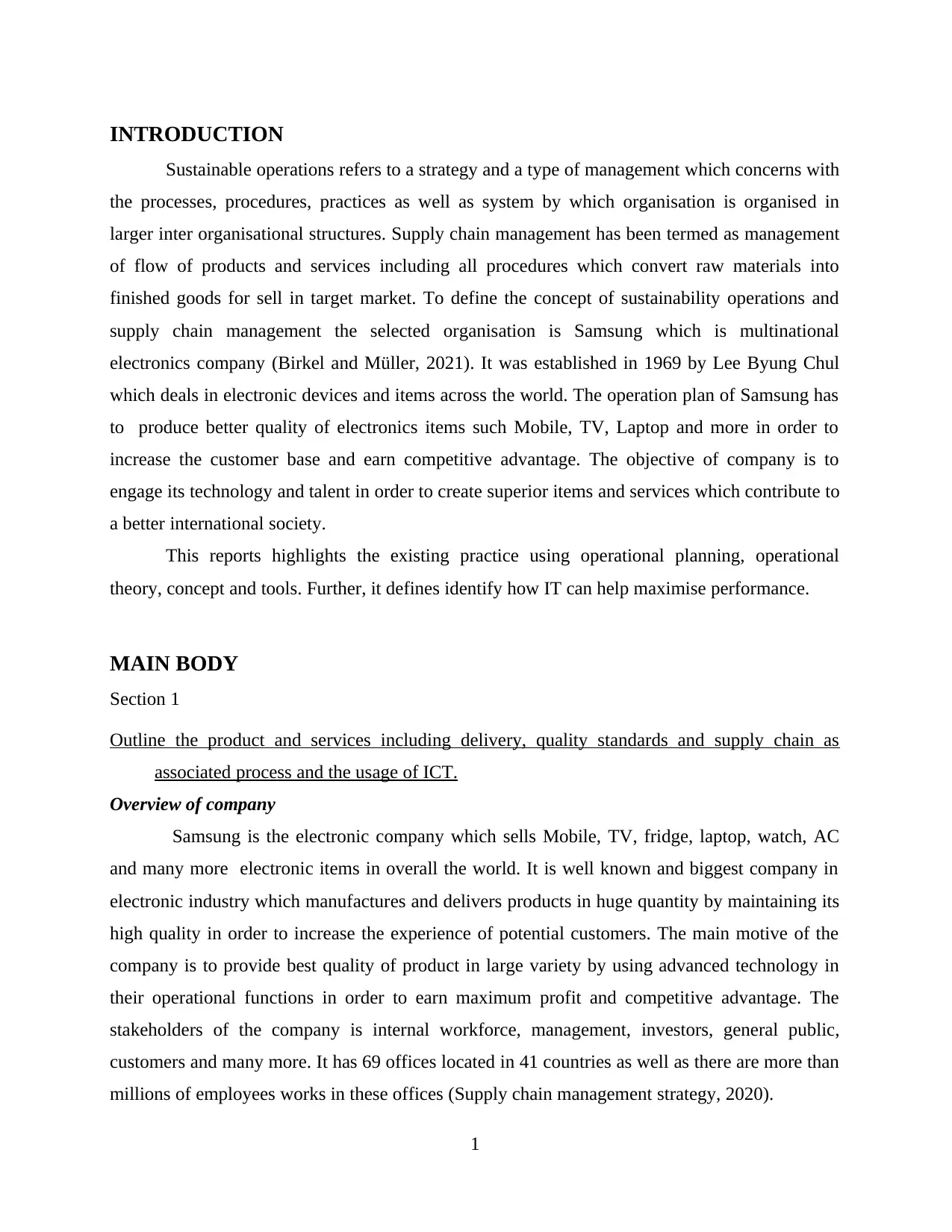
INTRODUCTION
Sustainable operations refers to a strategy and a type of management which concerns with
the processes, procedures, practices as well as system by which organisation is organised in
larger inter organisational structures. Supply chain management has been termed as management
of flow of products and services including all procedures which convert raw materials into
finished goods for sell in target market. To define the concept of sustainability operations and
supply chain management the selected organisation is Samsung which is multinational
electronics company (Birkel and Müller, 2021). It was established in 1969 by Lee Byung Chul
which deals in electronic devices and items across the world. The operation plan of Samsung has
to produce better quality of electronics items such Mobile, TV, Laptop and more in order to
increase the customer base and earn competitive advantage. The objective of company is to
engage its technology and talent in order to create superior items and services which contribute to
a better international society.
This reports highlights the existing practice using operational planning, operational
theory, concept and tools. Further, it defines identify how IT can help maximise performance.
MAIN BODY
Section 1
Outline the product and services including delivery, quality standards and supply chain as
associated process and the usage of ICT.
Overview of company
Samsung is the electronic company which sells Mobile, TV, fridge, laptop, watch, AC
and many more electronic items in overall the world. It is well known and biggest company in
electronic industry which manufactures and delivers products in huge quantity by maintaining its
high quality in order to increase the experience of potential customers. The main motive of the
company is to provide best quality of product in large variety by using advanced technology in
their operational functions in order to earn maximum profit and competitive advantage. The
stakeholders of the company is internal workforce, management, investors, general public,
customers and many more. It has 69 offices located in 41 countries as well as there are more than
millions of employees works in these offices (Supply chain management strategy, 2020).
1
Sustainable operations refers to a strategy and a type of management which concerns with
the processes, procedures, practices as well as system by which organisation is organised in
larger inter organisational structures. Supply chain management has been termed as management
of flow of products and services including all procedures which convert raw materials into
finished goods for sell in target market. To define the concept of sustainability operations and
supply chain management the selected organisation is Samsung which is multinational
electronics company (Birkel and Müller, 2021). It was established in 1969 by Lee Byung Chul
which deals in electronic devices and items across the world. The operation plan of Samsung has
to produce better quality of electronics items such Mobile, TV, Laptop and more in order to
increase the customer base and earn competitive advantage. The objective of company is to
engage its technology and talent in order to create superior items and services which contribute to
a better international society.
This reports highlights the existing practice using operational planning, operational
theory, concept and tools. Further, it defines identify how IT can help maximise performance.
MAIN BODY
Section 1
Outline the product and services including delivery, quality standards and supply chain as
associated process and the usage of ICT.
Overview of company
Samsung is the electronic company which sells Mobile, TV, fridge, laptop, watch, AC
and many more electronic items in overall the world. It is well known and biggest company in
electronic industry which manufactures and delivers products in huge quantity by maintaining its
high quality in order to increase the experience of potential customers. The main motive of the
company is to provide best quality of product in large variety by using advanced technology in
their operational functions in order to earn maximum profit and competitive advantage. The
stakeholders of the company is internal workforce, management, investors, general public,
customers and many more. It has 69 offices located in 41 countries as well as there are more than
millions of employees works in these offices (Supply chain management strategy, 2020).
1
Paraphrase This Document
Need a fresh take? Get an instant paraphrase of this document with our AI Paraphraser
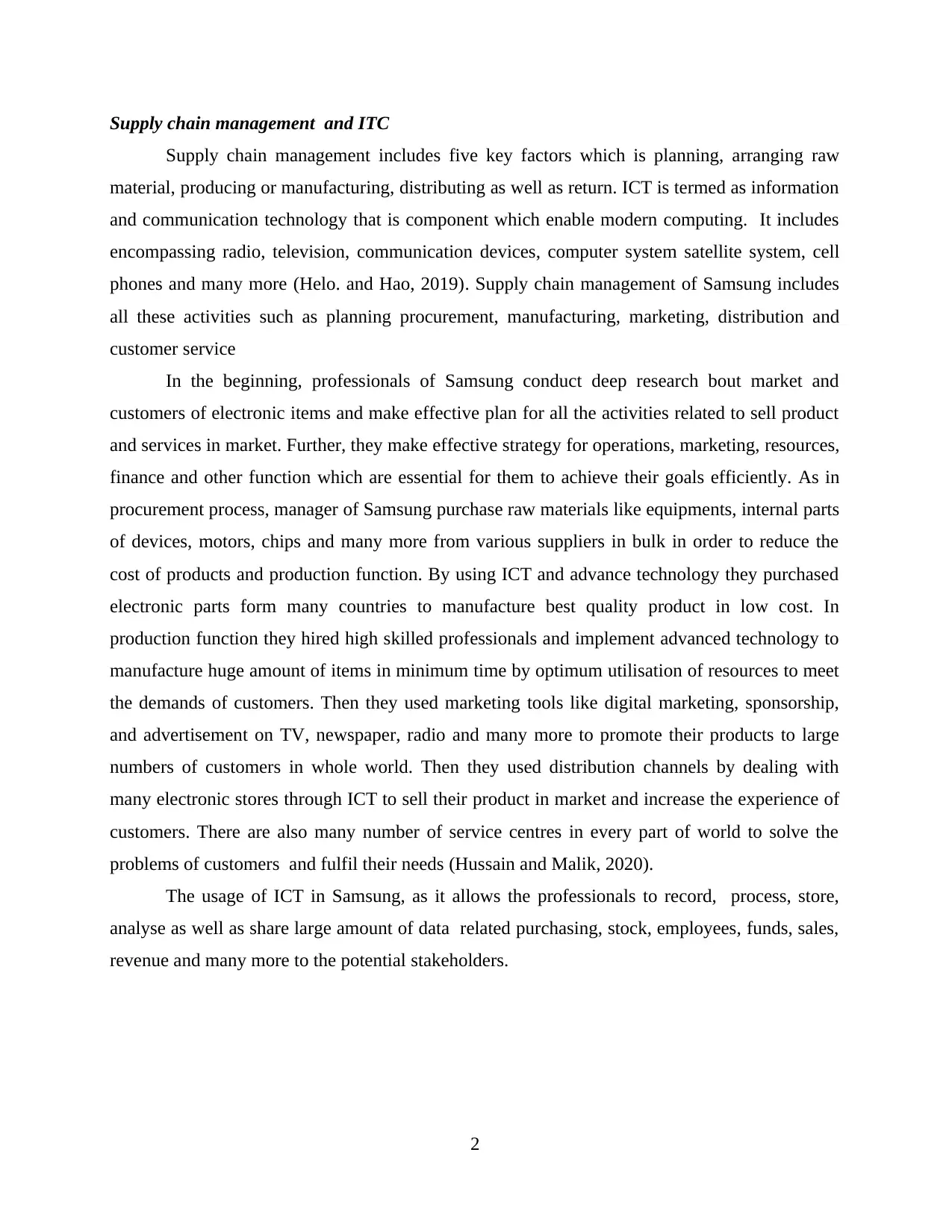
Supply chain management and ITC
Supply chain management includes five key factors which is planning, arranging raw
material, producing or manufacturing, distributing as well as return. ICT is termed as information
and communication technology that is component which enable modern computing. It includes
encompassing radio, television, communication devices, computer system satellite system, cell
phones and many more (Helo. and Hao, 2019). Supply chain management of Samsung includes
all these activities such as planning procurement, manufacturing, marketing, distribution and
customer service
In the beginning, professionals of Samsung conduct deep research bout market and
customers of electronic items and make effective plan for all the activities related to sell product
and services in market. Further, they make effective strategy for operations, marketing, resources,
finance and other function which are essential for them to achieve their goals efficiently. As in
procurement process, manager of Samsung purchase raw materials like equipments, internal parts
of devices, motors, chips and many more from various suppliers in bulk in order to reduce the
cost of products and production function. By using ICT and advance technology they purchased
electronic parts form many countries to manufacture best quality product in low cost. In
production function they hired high skilled professionals and implement advanced technology to
manufacture huge amount of items in minimum time by optimum utilisation of resources to meet
the demands of customers. Then they used marketing tools like digital marketing, sponsorship,
and advertisement on TV, newspaper, radio and many more to promote their products to large
numbers of customers in whole world. Then they used distribution channels by dealing with
many electronic stores through ICT to sell their product in market and increase the experience of
customers. There are also many number of service centres in every part of world to solve the
problems of customers and fulfil their needs (Hussain and Malik, 2020).
The usage of ICT in Samsung, as it allows the professionals to record, process, store,
analyse as well as share large amount of data related purchasing, stock, employees, funds, sales,
revenue and many more to the potential stakeholders.
2
Supply chain management includes five key factors which is planning, arranging raw
material, producing or manufacturing, distributing as well as return. ICT is termed as information
and communication technology that is component which enable modern computing. It includes
encompassing radio, television, communication devices, computer system satellite system, cell
phones and many more (Helo. and Hao, 2019). Supply chain management of Samsung includes
all these activities such as planning procurement, manufacturing, marketing, distribution and
customer service
In the beginning, professionals of Samsung conduct deep research bout market and
customers of electronic items and make effective plan for all the activities related to sell product
and services in market. Further, they make effective strategy for operations, marketing, resources,
finance and other function which are essential for them to achieve their goals efficiently. As in
procurement process, manager of Samsung purchase raw materials like equipments, internal parts
of devices, motors, chips and many more from various suppliers in bulk in order to reduce the
cost of products and production function. By using ICT and advance technology they purchased
electronic parts form many countries to manufacture best quality product in low cost. In
production function they hired high skilled professionals and implement advanced technology to
manufacture huge amount of items in minimum time by optimum utilisation of resources to meet
the demands of customers. Then they used marketing tools like digital marketing, sponsorship,
and advertisement on TV, newspaper, radio and many more to promote their products to large
numbers of customers in whole world. Then they used distribution channels by dealing with
many electronic stores through ICT to sell their product in market and increase the experience of
customers. There are also many number of service centres in every part of world to solve the
problems of customers and fulfil their needs (Hussain and Malik, 2020).
The usage of ICT in Samsung, as it allows the professionals to record, process, store,
analyse as well as share large amount of data related purchasing, stock, employees, funds, sales,
revenue and many more to the potential stakeholders.
2
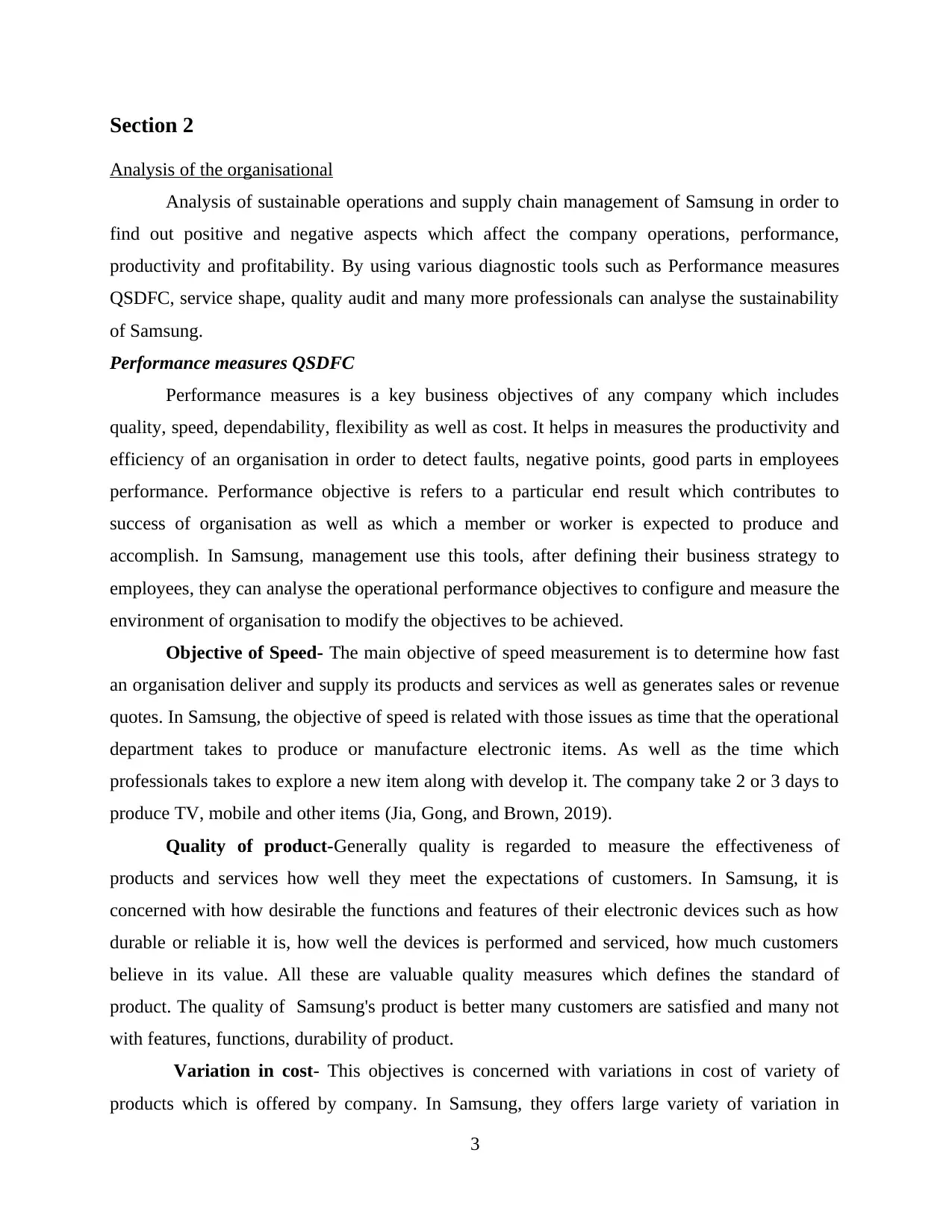
Section 2
Analysis of the organisational
Analysis of sustainable operations and supply chain management of Samsung in order to
find out positive and negative aspects which affect the company operations, performance,
productivity and profitability. By using various diagnostic tools such as Performance measures
QSDFC, service shape, quality audit and many more professionals can analyse the sustainability
of Samsung.
Performance measures QSDFC
Performance measures is a key business objectives of any company which includes
quality, speed, dependability, flexibility as well as cost. It helps in measures the productivity and
efficiency of an organisation in order to detect faults, negative points, good parts in employees
performance. Performance objective is refers to a particular end result which contributes to
success of organisation as well as which a member or worker is expected to produce and
accomplish. In Samsung, management use this tools, after defining their business strategy to
employees, they can analyse the operational performance objectives to configure and measure the
environment of organisation to modify the objectives to be achieved.
Objective of Speed- The main objective of speed measurement is to determine how fast
an organisation deliver and supply its products and services as well as generates sales or revenue
quotes. In Samsung, the objective of speed is related with those issues as time that the operational
department takes to produce or manufacture electronic items. As well as the time which
professionals takes to explore a new item along with develop it. The company take 2 or 3 days to
produce TV, mobile and other items (Jia, Gong, and Brown, 2019).
Quality of product-Generally quality is regarded to measure the effectiveness of
products and services how well they meet the expectations of customers. In Samsung, it is
concerned with how desirable the functions and features of their electronic devices such as how
durable or reliable it is, how well the devices is performed and serviced, how much customers
believe in its value. All these are valuable quality measures which defines the standard of
product. The quality of Samsung's product is better many customers are satisfied and many not
with features, functions, durability of product.
Variation in cost- This objectives is concerned with variations in cost of variety of
products which is offered by company. In Samsung, they offers large variety of variation in
3
Analysis of the organisational
Analysis of sustainable operations and supply chain management of Samsung in order to
find out positive and negative aspects which affect the company operations, performance,
productivity and profitability. By using various diagnostic tools such as Performance measures
QSDFC, service shape, quality audit and many more professionals can analyse the sustainability
of Samsung.
Performance measures QSDFC
Performance measures is a key business objectives of any company which includes
quality, speed, dependability, flexibility as well as cost. It helps in measures the productivity and
efficiency of an organisation in order to detect faults, negative points, good parts in employees
performance. Performance objective is refers to a particular end result which contributes to
success of organisation as well as which a member or worker is expected to produce and
accomplish. In Samsung, management use this tools, after defining their business strategy to
employees, they can analyse the operational performance objectives to configure and measure the
environment of organisation to modify the objectives to be achieved.
Objective of Speed- The main objective of speed measurement is to determine how fast
an organisation deliver and supply its products and services as well as generates sales or revenue
quotes. In Samsung, the objective of speed is related with those issues as time that the operational
department takes to produce or manufacture electronic items. As well as the time which
professionals takes to explore a new item along with develop it. The company take 2 or 3 days to
produce TV, mobile and other items (Jia, Gong, and Brown, 2019).
Quality of product-Generally quality is regarded to measure the effectiveness of
products and services how well they meet the expectations of customers. In Samsung, it is
concerned with how desirable the functions and features of their electronic devices such as how
durable or reliable it is, how well the devices is performed and serviced, how much customers
believe in its value. All these are valuable quality measures which defines the standard of
product. The quality of Samsung's product is better many customers are satisfied and many not
with features, functions, durability of product.
Variation in cost- This objectives is concerned with variations in cost of variety of
products which is offered by company. In Samsung, they offers large variety of variation in
3
⊘ This is a preview!⊘
Do you want full access?
Subscribe today to unlock all pages.

Trusted by 1+ million students worldwide
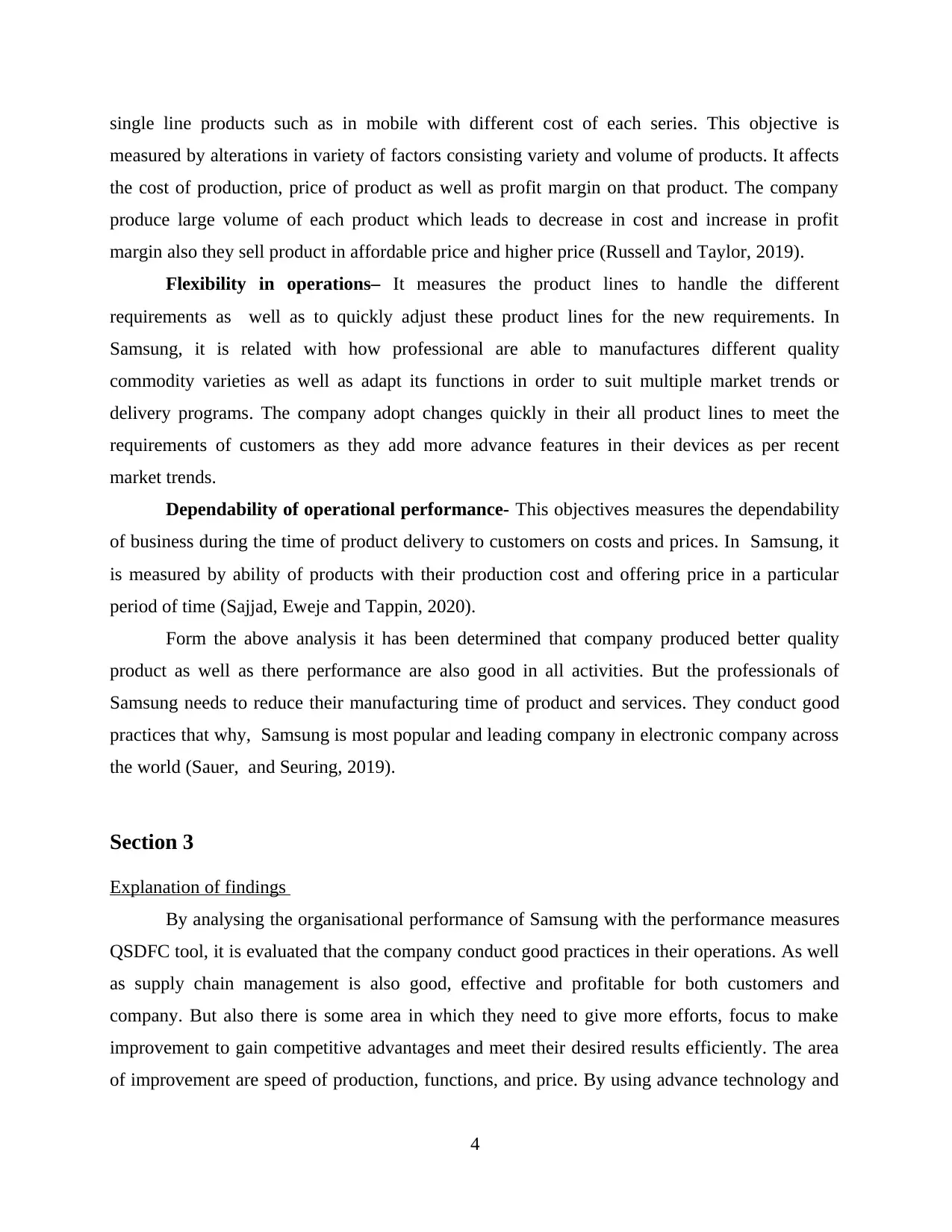
single line products such as in mobile with different cost of each series. This objective is
measured by alterations in variety of factors consisting variety and volume of products. It affects
the cost of production, price of product as well as profit margin on that product. The company
produce large volume of each product which leads to decrease in cost and increase in profit
margin also they sell product in affordable price and higher price (Russell and Taylor, 2019).
Flexibility in operations– It measures the product lines to handle the different
requirements as well as to quickly adjust these product lines for the new requirements. In
Samsung, it is related with how professional are able to manufactures different quality
commodity varieties as well as adapt its functions in order to suit multiple market trends or
delivery programs. The company adopt changes quickly in their all product lines to meet the
requirements of customers as they add more advance features in their devices as per recent
market trends.
Dependability of operational performance- This objectives measures the dependability
of business during the time of product delivery to customers on costs and prices. In Samsung, it
is measured by ability of products with their production cost and offering price in a particular
period of time (Sajjad, Eweje and Tappin, 2020).
Form the above analysis it has been determined that company produced better quality
product as well as there performance are also good in all activities. But the professionals of
Samsung needs to reduce their manufacturing time of product and services. They conduct good
practices that why, Samsung is most popular and leading company in electronic company across
the world (Sauer, and Seuring, 2019).
Section 3
Explanation of findings
By analysing the organisational performance of Samsung with the performance measures
QSDFC tool, it is evaluated that the company conduct good practices in their operations. As well
as supply chain management is also good, effective and profitable for both customers and
company. But also there is some area in which they need to give more efforts, focus to make
improvement to gain competitive advantages and meet their desired results efficiently. The area
of improvement are speed of production, functions, and price. By using advance technology and
4
measured by alterations in variety of factors consisting variety and volume of products. It affects
the cost of production, price of product as well as profit margin on that product. The company
produce large volume of each product which leads to decrease in cost and increase in profit
margin also they sell product in affordable price and higher price (Russell and Taylor, 2019).
Flexibility in operations– It measures the product lines to handle the different
requirements as well as to quickly adjust these product lines for the new requirements. In
Samsung, it is related with how professional are able to manufactures different quality
commodity varieties as well as adapt its functions in order to suit multiple market trends or
delivery programs. The company adopt changes quickly in their all product lines to meet the
requirements of customers as they add more advance features in their devices as per recent
market trends.
Dependability of operational performance- This objectives measures the dependability
of business during the time of product delivery to customers on costs and prices. In Samsung, it
is measured by ability of products with their production cost and offering price in a particular
period of time (Sajjad, Eweje and Tappin, 2020).
Form the above analysis it has been determined that company produced better quality
product as well as there performance are also good in all activities. But the professionals of
Samsung needs to reduce their manufacturing time of product and services. They conduct good
practices that why, Samsung is most popular and leading company in electronic company across
the world (Sauer, and Seuring, 2019).
Section 3
Explanation of findings
By analysing the organisational performance of Samsung with the performance measures
QSDFC tool, it is evaluated that the company conduct good practices in their operations. As well
as supply chain management is also good, effective and profitable for both customers and
company. But also there is some area in which they need to give more efforts, focus to make
improvement to gain competitive advantages and meet their desired results efficiently. The area
of improvement are speed of production, functions, and price. By using advance technology and
4
Paraphrase This Document
Need a fresh take? Get an instant paraphrase of this document with our AI Paraphraser
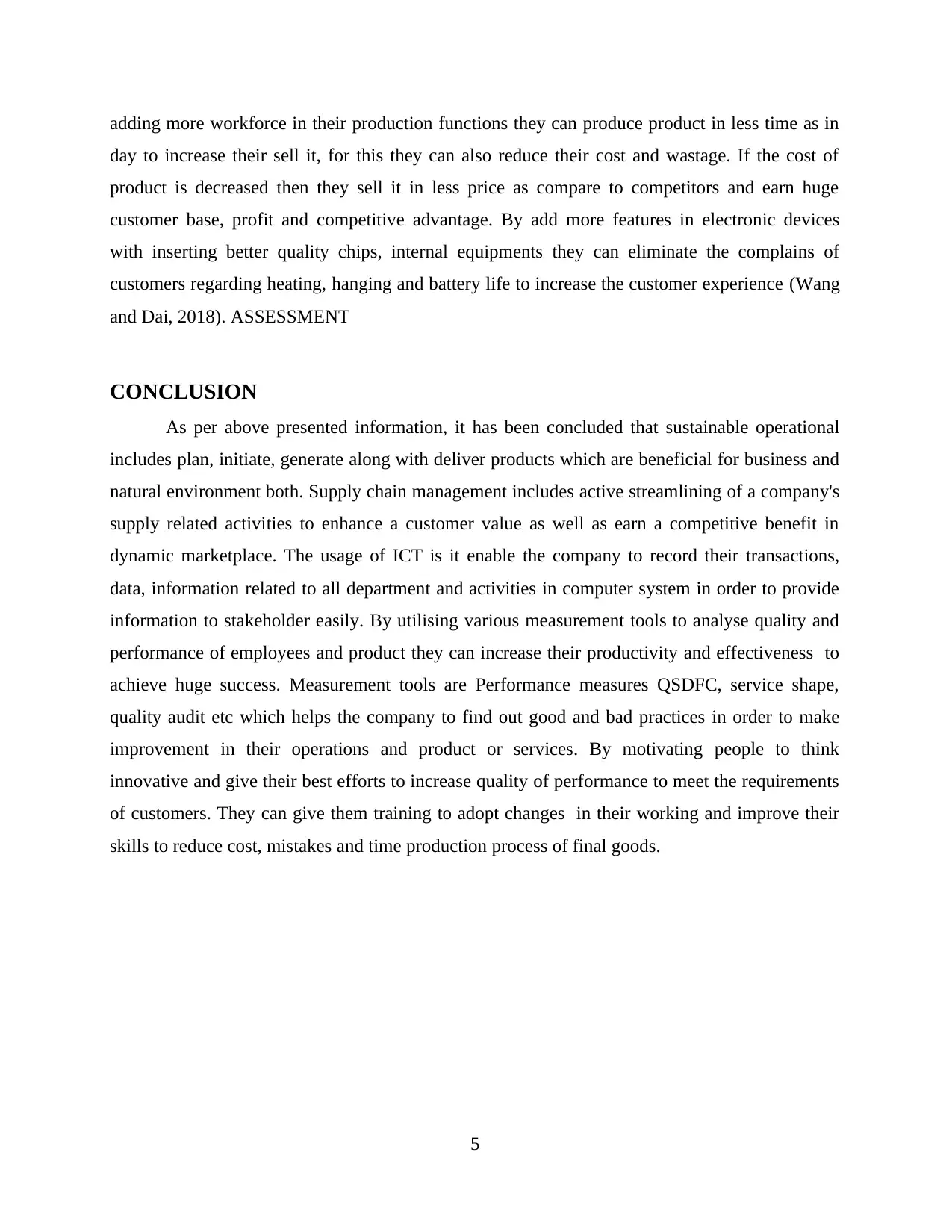
adding more workforce in their production functions they can produce product in less time as in
day to increase their sell it, for this they can also reduce their cost and wastage. If the cost of
product is decreased then they sell it in less price as compare to competitors and earn huge
customer base, profit and competitive advantage. By add more features in electronic devices
with inserting better quality chips, internal equipments they can eliminate the complains of
customers regarding heating, hanging and battery life to increase the customer experience (Wang
and Dai, 2018). ASSESSMENT
CONCLUSION
As per above presented information, it has been concluded that sustainable operational
includes plan, initiate, generate along with deliver products which are beneficial for business and
natural environment both. Supply chain management includes active streamlining of a company's
supply related activities to enhance a customer value as well as earn a competitive benefit in
dynamic marketplace. The usage of ICT is it enable the company to record their transactions,
data, information related to all department and activities in computer system in order to provide
information to stakeholder easily. By utilising various measurement tools to analyse quality and
performance of employees and product they can increase their productivity and effectiveness to
achieve huge success. Measurement tools are Performance measures QSDFC, service shape,
quality audit etc which helps the company to find out good and bad practices in order to make
improvement in their operations and product or services. By motivating people to think
innovative and give their best efforts to increase quality of performance to meet the requirements
of customers. They can give them training to adopt changes in their working and improve their
skills to reduce cost, mistakes and time production process of final goods.
5
day to increase their sell it, for this they can also reduce their cost and wastage. If the cost of
product is decreased then they sell it in less price as compare to competitors and earn huge
customer base, profit and competitive advantage. By add more features in electronic devices
with inserting better quality chips, internal equipments they can eliminate the complains of
customers regarding heating, hanging and battery life to increase the customer experience (Wang
and Dai, 2018). ASSESSMENT
CONCLUSION
As per above presented information, it has been concluded that sustainable operational
includes plan, initiate, generate along with deliver products which are beneficial for business and
natural environment both. Supply chain management includes active streamlining of a company's
supply related activities to enhance a customer value as well as earn a competitive benefit in
dynamic marketplace. The usage of ICT is it enable the company to record their transactions,
data, information related to all department and activities in computer system in order to provide
information to stakeholder easily. By utilising various measurement tools to analyse quality and
performance of employees and product they can increase their productivity and effectiveness to
achieve huge success. Measurement tools are Performance measures QSDFC, service shape,
quality audit etc which helps the company to find out good and bad practices in order to make
improvement in their operations and product or services. By motivating people to think
innovative and give their best efforts to increase quality of performance to meet the requirements
of customers. They can give them training to adopt changes in their working and improve their
skills to reduce cost, mistakes and time production process of final goods.
5
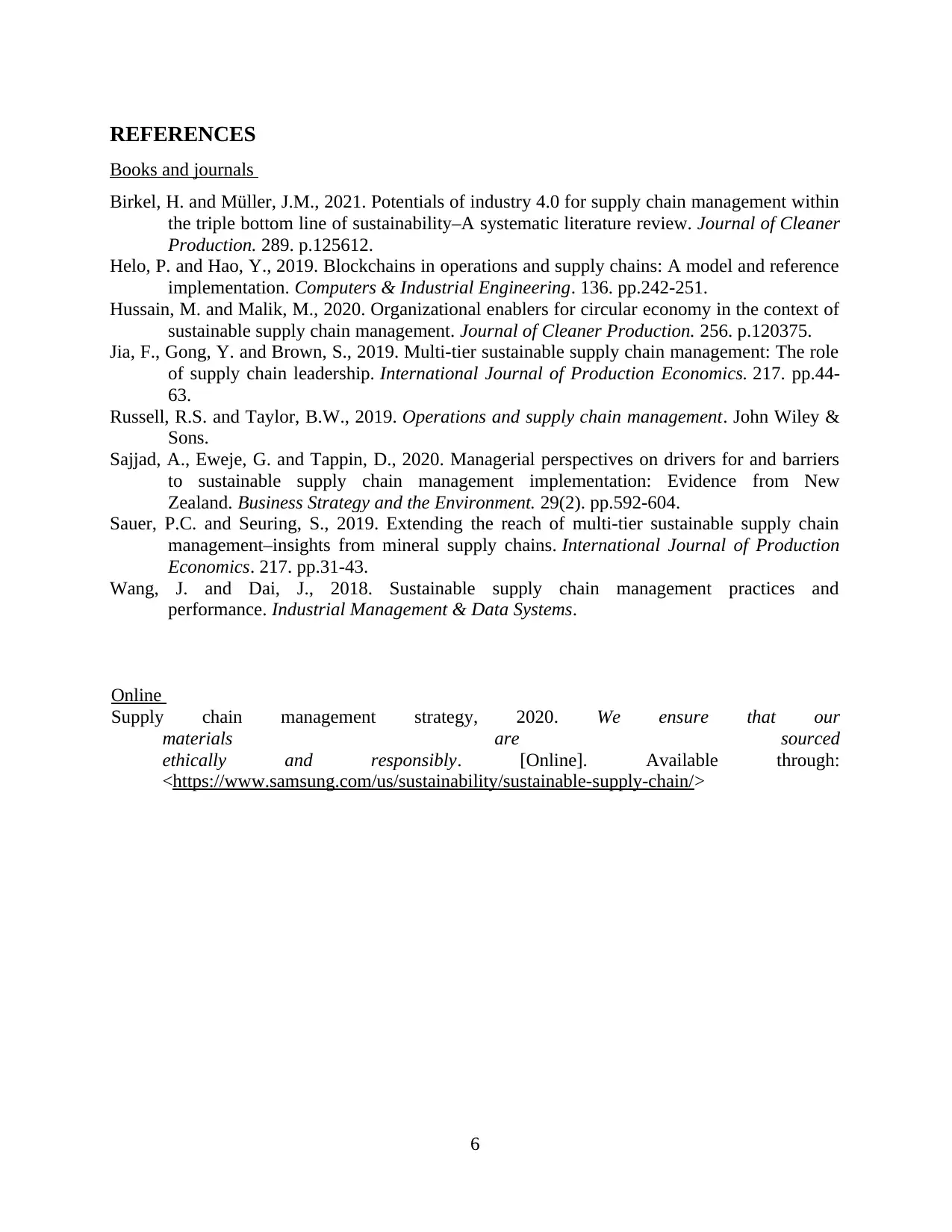
REFERENCES
Books and journals
Birkel, H. and Müller, J.M., 2021. Potentials of industry 4.0 for supply chain management within
the triple bottom line of sustainability–A systematic literature review. Journal of Cleaner
Production. 289. p.125612.
Helo, P. and Hao, Y., 2019. Blockchains in operations and supply chains: A model and reference
implementation. Computers & Industrial Engineering. 136. pp.242-251.
Hussain, M. and Malik, M., 2020. Organizational enablers for circular economy in the context of
sustainable supply chain management. Journal of Cleaner Production. 256. p.120375.
Jia, F., Gong, Y. and Brown, S., 2019. Multi-tier sustainable supply chain management: The role
of supply chain leadership. International Journal of Production Economics. 217. pp.44-
63.
Russell, R.S. and Taylor, B.W., 2019. Operations and supply chain management. John Wiley &
Sons.
Sajjad, A., Eweje, G. and Tappin, D., 2020. Managerial perspectives on drivers for and barriers
to sustainable supply chain management implementation: Evidence from New
Zealand. Business Strategy and the Environment. 29(2). pp.592-604.
Sauer, P.C. and Seuring, S., 2019. Extending the reach of multi-tier sustainable supply chain
management–insights from mineral supply chains. International Journal of Production
Economics. 217. pp.31-43.
Wang, J. and Dai, J., 2018. Sustainable supply chain management practices and
performance. Industrial Management & Data Systems.
Online
Supply chain management strategy, 2020. We ensure that our
materials are sourced
ethically and responsibly. [Online]. Available through:
<https://www.samsung.com/us/sustainability/sustainable-supply-chain/>
6
Books and journals
Birkel, H. and Müller, J.M., 2021. Potentials of industry 4.0 for supply chain management within
the triple bottom line of sustainability–A systematic literature review. Journal of Cleaner
Production. 289. p.125612.
Helo, P. and Hao, Y., 2019. Blockchains in operations and supply chains: A model and reference
implementation. Computers & Industrial Engineering. 136. pp.242-251.
Hussain, M. and Malik, M., 2020. Organizational enablers for circular economy in the context of
sustainable supply chain management. Journal of Cleaner Production. 256. p.120375.
Jia, F., Gong, Y. and Brown, S., 2019. Multi-tier sustainable supply chain management: The role
of supply chain leadership. International Journal of Production Economics. 217. pp.44-
63.
Russell, R.S. and Taylor, B.W., 2019. Operations and supply chain management. John Wiley &
Sons.
Sajjad, A., Eweje, G. and Tappin, D., 2020. Managerial perspectives on drivers for and barriers
to sustainable supply chain management implementation: Evidence from New
Zealand. Business Strategy and the Environment. 29(2). pp.592-604.
Sauer, P.C. and Seuring, S., 2019. Extending the reach of multi-tier sustainable supply chain
management–insights from mineral supply chains. International Journal of Production
Economics. 217. pp.31-43.
Wang, J. and Dai, J., 2018. Sustainable supply chain management practices and
performance. Industrial Management & Data Systems.
Online
Supply chain management strategy, 2020. We ensure that our
materials are sourced
ethically and responsibly. [Online]. Available through:
<https://www.samsung.com/us/sustainability/sustainable-supply-chain/>
6
⊘ This is a preview!⊘
Do you want full access?
Subscribe today to unlock all pages.

Trusted by 1+ million students worldwide
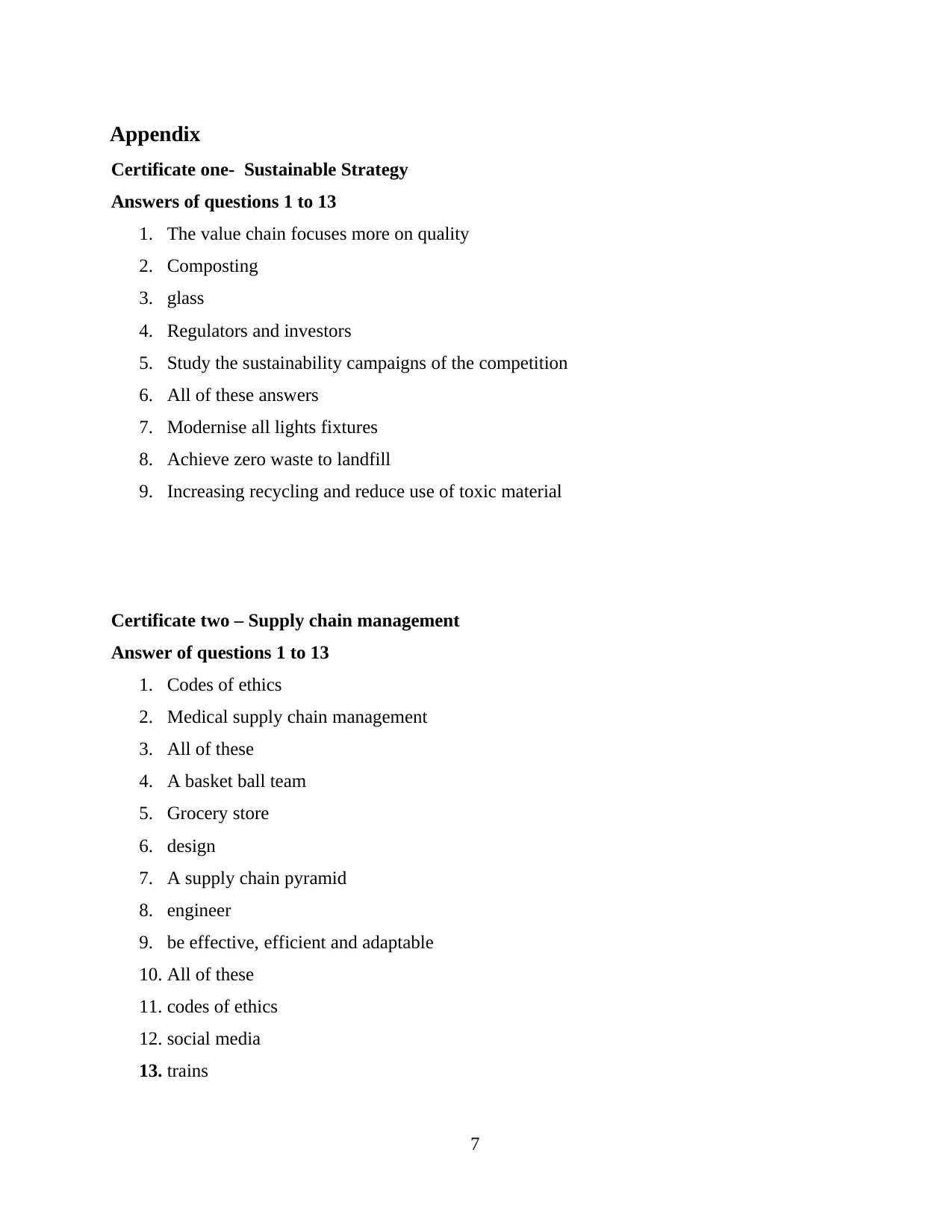
Appendix
Certificate one- Sustainable Strategy
Answers of questions 1 to 13
1. The value chain focuses more on quality
2. Composting
3. glass
4. Regulators and investors
5. Study the sustainability campaigns of the competition
6. All of these answers
7. Modernise all lights fixtures
8. Achieve zero waste to landfill
9. Increasing recycling and reduce use of toxic material
Certificate two – Supply chain management
Answer of questions 1 to 13
1. Codes of ethics
2. Medical supply chain management
3. All of these
4. A basket ball team
5. Grocery store
6. design
7. A supply chain pyramid
8. engineer
9. be effective, efficient and adaptable
10. All of these
11. codes of ethics
12. social media
13. trains
7
Certificate one- Sustainable Strategy
Answers of questions 1 to 13
1. The value chain focuses more on quality
2. Composting
3. glass
4. Regulators and investors
5. Study the sustainability campaigns of the competition
6. All of these answers
7. Modernise all lights fixtures
8. Achieve zero waste to landfill
9. Increasing recycling and reduce use of toxic material
Certificate two – Supply chain management
Answer of questions 1 to 13
1. Codes of ethics
2. Medical supply chain management
3. All of these
4. A basket ball team
5. Grocery store
6. design
7. A supply chain pyramid
8. engineer
9. be effective, efficient and adaptable
10. All of these
11. codes of ethics
12. social media
13. trains
7
Paraphrase This Document
Need a fresh take? Get an instant paraphrase of this document with our AI Paraphraser
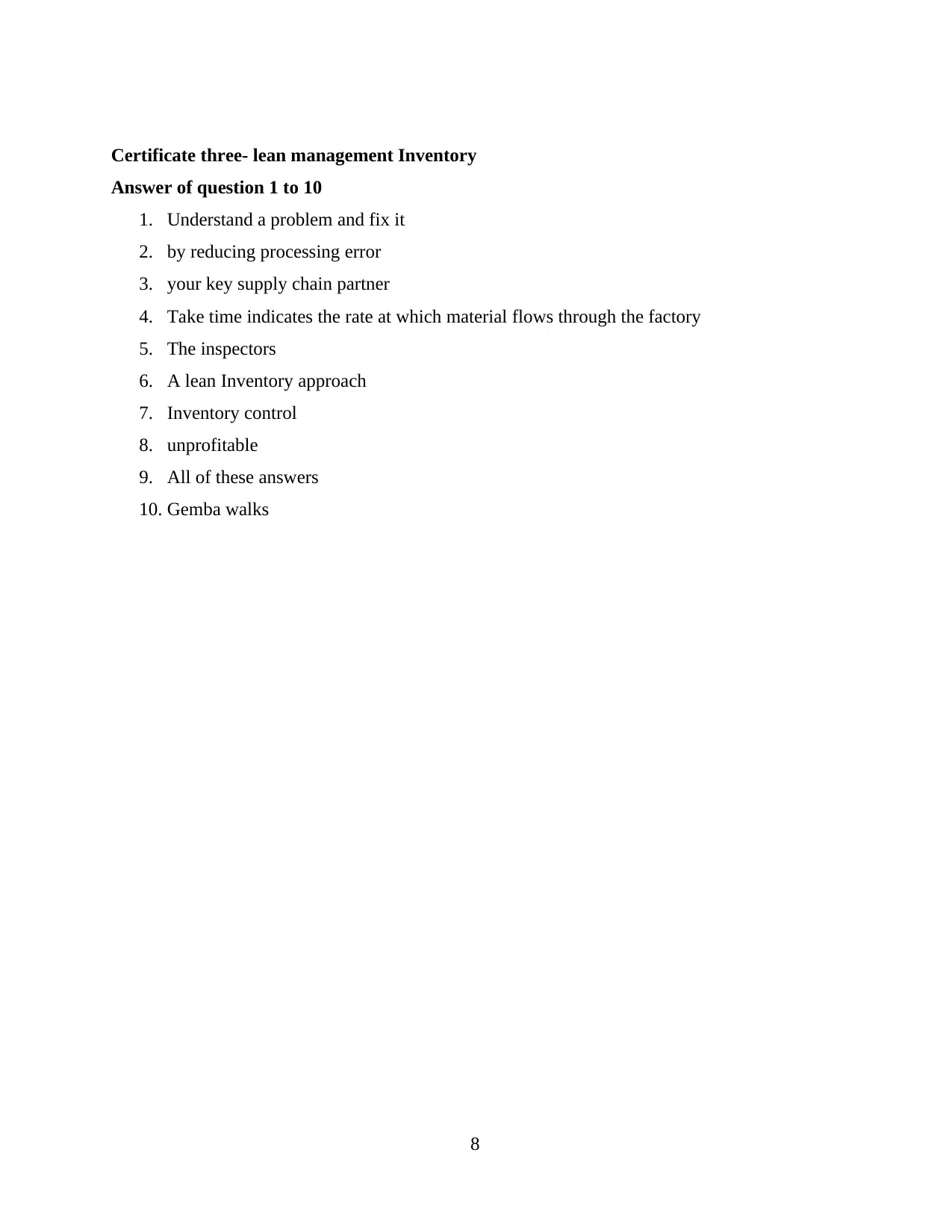
Certificate three- lean management Inventory
Answer of question 1 to 10
1. Understand a problem and fix it
2. by reducing processing error
3. your key supply chain partner
4. Take time indicates the rate at which material flows through the factory
5. The inspectors
6. A lean Inventory approach
7. Inventory control
8. unprofitable
9. All of these answers
10. Gemba walks
8
Answer of question 1 to 10
1. Understand a problem and fix it
2. by reducing processing error
3. your key supply chain partner
4. Take time indicates the rate at which material flows through the factory
5. The inspectors
6. A lean Inventory approach
7. Inventory control
8. unprofitable
9. All of these answers
10. Gemba walks
8
1 out of 11
Related Documents
Your All-in-One AI-Powered Toolkit for Academic Success.
+13062052269
info@desklib.com
Available 24*7 on WhatsApp / Email
![[object Object]](/_next/static/media/star-bottom.7253800d.svg)
Unlock your academic potential
Copyright © 2020–2025 A2Z Services. All Rights Reserved. Developed and managed by ZUCOL.




